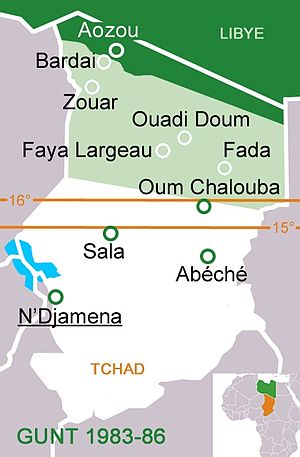Battle of Faya-Largeau
| date | February 18, 1978 |
|---|---|
| place | Faya-Largeau |
| output | Capture of the city by the FAP |
| Territorial changes | FAP and Libya take the last Chadian bases in the north of the country |
| Parties to the conflict | |
|---|---|
| Commander | |
| Troop strength | |
| 5000 | 2500 FAP 4,000 Libyans |
The Battle of Faya-Largeau was one of the most important combat operations in the early stages of the Libyan-Chadian border war.
prehistory
After a government of national unity in Chad on August 29, 1978 through an agreement between the leader of the anti-Libyan militia FAN, Hissan Habre , and General Felix Malloum , who came to power in a coup against the President of Chad Tombalbaye , was closed, Ghaddafi saw his influence in northern Chad threatened as he had always exploited the fragmentation of the country. As a result, Qaddafi increased Libyan engagement in the conflict area and supported the pro-Libyan FAP under the leadership of Goukouni Oueddei . This coalition already had large areas of northern Chad, which had fallen to FROLINAT in 1977 , a resistance group led by Ibrahim Abachta , which eventually split into FAN and FAP. As part of the so-called Ibrahim Abachta offensive, which began on January 29, 1978, the FAP wanted to conquer the last Chadian bases with Libyan support.
course
The offensive of the Libyan coalition quickly achieved success, as the Libyan armed forces were also represented with ground troops for the first time . But they were careful to only intervene in the fighting by delivering heavy weapons, artillery and air support. The aim of the offensive was the bases of Faya-Largeau , Fada and Ounianga Kebir , with the most important battle occurring in Faya-Largeau, where the successful pro-Libyan army met a larger Chadian force consisting of 5,000 defenders. Despite the numerically strong defense, the provincial capital fell to the Libyan coalition on February 18, 1978, as it was better equipped, including Strela 2 anti- aircraft missiles and the Libyan air support to the defenders.
consequences
The fall of Faya-Largeau was a severe blow to the Chadian troops and finally removed control of the north of the country. In order to stop the successful offensive of the FAP in association with Libyan troops, Malloum was forced to agree a ceasefire on February 19, 1978.
As the war progressed, Faya-Largeau, the most important city in northern Chad, was repeatedly at the center of the fighting.
Individual evidence
- ↑ Barrage on the Tibesti . In: ZEIT ONLINE . ( zeit.de [accessed on May 12, 2018]).
- ↑ James Brooke: CHAD FINDS UNITY IN WAR WITH LIBYA . ( nytimes.com [accessed May 12, 2018]).
- ^ EISA Chad: Defunct parties. Retrieved May 12, 2018 .
- ^ History (Chad) . ISBN 978-1-159-01892-4 .
- ↑ Chad's Habre starts to beat back rebels, but key battle ahead . In: Christian Science Monitor . July 26, 1983, ISSN 0882-7729 ( csmonitor.com [accessed May 12, 2018]).
